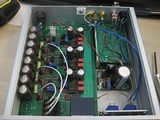Spacehead
100+ Head-Fier
- Joined
- Jan 1, 2010
- Posts
- 423
- Likes
- 16
Quote:
I think PPA v2 is a high end amplifier, it is very transparent, you shouldn't need any better amplifier if you build this.
It should be good for any headphone out there.
| Originally Posted by nini_knoxville /img/forum/go_quote.gif hi, i found the PPAv2 diy headphoneamp project through google and i don't know if it is a good amp? i currently have the sennheiser hd590... but its getting kinda old.. maybe soon the hd650 or if i have enough money dhe hd800 (dreaming). i wanted to try a diy amp before i will buy (if needed) a mid/high end amp (lehmann linear or grace m902) just to really know.. how good my headphones can be/get. so... my question is.. is the ppav2 a good starting point? i have soldering skills, but i'm not a audio electronic freak, but a computer programmer and have some microcontroller experience (maybe i could add an display and controll the amp digitally or so) |
I think PPA v2 is a high end amplifier, it is very transparent, you shouldn't need any better amplifier if you build this.
It should be good for any headphone out there.






























